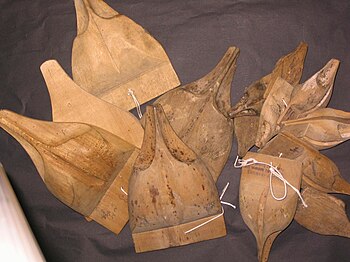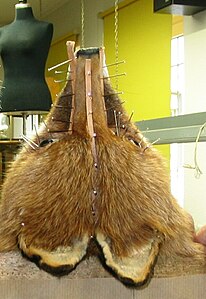Fur necklace head shape
A Pelzkollier-head shape according to the size as a fox's head shape , Marder head shape or ermine head shape referred to, serves as the basis for forming the heads of Pelzkolliers, fur scarves in animal shape.
Cardboard shapes remain in the necklace. For finer work, wooden forms are used, which are removed again before the necklace is finished.
For the production and a more detailed history of these collars or scarves, see → fur necklaces .
history
The predecessor of the fur necklace was the so-called " flea fur ". A flea fur or flea fur , coming from Italian, also called Zibellino ("little sable"), was a small necklace made of ermine , sable , polecat or marten fur with an elaborate head, tail and paws, often decorated with precious stones Late Middle Ages and especially during the Renaissance came into vogue in European aristocratic circles and among the very wealthy bourgeoisie. It was worn slung over the shoulder or occasionally on a chain on the belt. Allegedly, the function of the flea fur should be to attract annoying insects such as fleas and to distract them from the wearer's body. Since the fleas react to body heat and not to hair, there are some indications that the fur, which is mainly to be carried in the hand, was only subsequently assigned the effect of a flea trap . [8] The heads were already shaped in the later style, but less flat. Nothing seems to be known about the production of these accessories, the manufacturer presumably remodeled the head shape individually each time.
Around the middle of the 19th these animal scarves came into fashion again, this time in large numbers for the broader bourgeoisie. A very big topic was the fur trimmings, consisting of a fur hat , fur scarf, fur gloves and fur muff . The fashion soon was not satisfied with one fur animal, but demanded several, with the largest possible heads and as many tails and paws as possible: “The culmination of this fashion exaggeration were the fur animal heads, which also emit 'sounds', and their little snouts with a muzzle biting was refused ”, these accessories were often provided with“ exposed heads and tails ”, especially the many parts made from ermine fur. It was popular to have a small ermine or a fox's head and front paws peek out of the ermine or white fox muff.
Thanks to their rarity and popularity, necklaces made from silver fox fur were extremely valuable. They were imitated by a fur refinement of less expensive types of fur, or the common red fox was used in its natural state. Not every lady wore such opulent fashion accessories. At the same time, the much smaller marten necklaces, polecat necklaces and ermine necklaces were also popular, with the increase in mink breeding especially mink necklaces .
The dark tip of the nose (the nose sponge), glass eyes and fur ears belong to an elaborated head. Rarely did one go so far in naturalization that one also worked in a set of teeth that was then already worked into the cardboard form. Such fur necklaces were still sold in Eastern Europe until around the 1980s.
In the mid-1950s, the era of fur necklaces came to an end. In the time of the fox necklaces there were also fox boas , long, narrow fur scarves that also had a fox head like a necklace as a one-sided finish. Around the 1980s, inexpensive boas made from fox tails were sold in large numbers, often with a head mounted on a cardboard mold.
Manufacturing
In 1950, the Viennese furrier Alexander Tuma described the industrial production of cardboard molds:
- “Large embossing machines press the head shapes of various sizes from strong red cardboard. First the cardboard is cut into strips, then the flat outlines are cut out with a punch knife over a block. Driven by an electric motor, the embossing form works the heads out under about 30 hundredweight of pressure. Around 40 models, from the smallest ermine heads to wolf skulls, are punched out and shaped in this way. Every hollow form made of cast steel has a corresponding metal counterpart that fits exactly and has to take into account the clear space in between, in which the cardboard to be embossed still has room.
- Usually the inner nasal cavity for the small nasal tip nail is cemented into the shape of the head; if a bit is added, the work is even more complicated. "
Elaborate red fox head , front head shaped with cardboard strips
Web links
Individual evidence
- ↑ a b Friedrich Lorenz: Rauchwareenkunde . 4th edition. People and Knowledge, Berlin 1958, p. 2008 .
- ↑ Konrad Haumann: Costume-historical foray through the centuries . In: Der Rauchwarenmarkt , March 12, 1943, p. 7.
- ↑ Alexander Tuma: Pelz-Lexikon. Fur and Rough Goods, Volume XIX . Alexander Tuma, Vienna 1950, p. 56, keyword “Kolier, also necklace” .
- ^ Marie Louise Steinbauer, Rudolf Kinzel: Marie Louise Pelze . Steinbock Verlag, Hannover 1973, pp. 118, 152-153
- ↑ Alexander Tuma: Pelz-Lexikon. Fur and Rauhwarenkunde, Volume XX . Alexander Tuma, Vienna 1950, p. 162, keyword “fur ingredients” .




